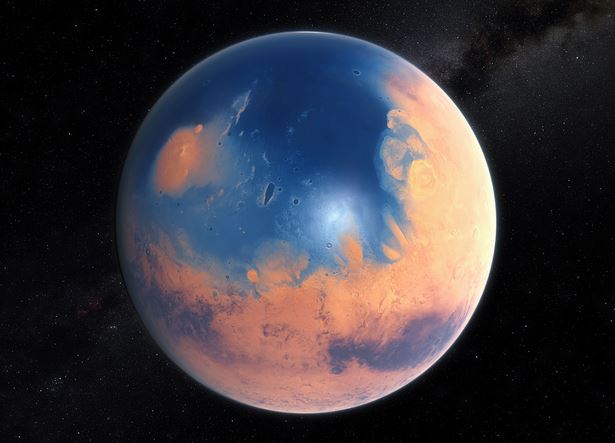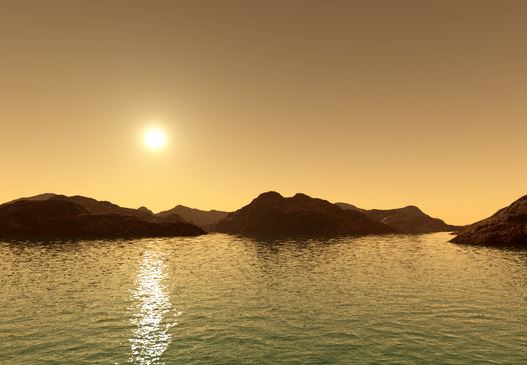Mars had so much water about 4.3 billion ago that it could have covered the whole planet in a massive ocean about 140 metres (460 feet) deep, scientists from NASA and the European Space Agency announced this week.
They think it is more likely that the ocean would have been in the northern hemisphere, where surface levels are lower, with depths perhaps greater than 1.6 kilometers (1 mile). About half the Red Planet’s northern hemisphere would have been covered in water.
Mars, the fourth planet from the Sun, after Mercury, Venus and Earth, is the second smallest in our Solar System, after Mercury. It is often referred to as the Red Planet because the abundant iron oxide on its surface gives it a reddish appearance. It is a terrestrial planet (composed primarily of silicate rocks or metals) with a thin atmosphere.

An artist’s impression of how Mars may have looked about 4 billion years ago. (Image: ESO)
Lead author of a paper published in the journal Science this week, Dr. Geronimo Villanueva, a planetary scientist at NASA’s Goddard Space Flight Center in Greenbelt, Maryland, USA, said:
“Our study provides a solid estimate of how much water Mars once had, by determining how much water was lost to space. With this work, we can better understand the history of water on Mars.”
Normal and heavy water
The new estimate of how much water Mars used to have comes after detailed observations of two forms of water in the Red Planet’s atmosphere: The familiar H2O, consisting of two hydrogen and one oxygen atom, and HDO, also known as semi-heavy water, a naturally-occurring variation of water where one hydrogen atom is replaced by deuterium (heavy hydrogen).
As HDO is heaver than H2O, it is less easily lost into space through evaporation. Therefore, the more water a planet loses, the higher the HDO-to-H2O ratio is.
The scientists distinguished the chemical signatures of H2O and HDO using the W. M. Keck Observatory, the NASA Infrared Telescope Facility, both in Hawaii, and ESO’s (European Southern Observatory’s) Very Large Telescope in Chile.
By comparing HDO and H2O concentrations, the researchers can measure how much the fraction of HDO has risen, and thus determine how much of the planet’s water has escaped into space. This in turn allows them to estimate how much water Mars used to have.

Did Mars once look much like Earth does today?
Co-author, Ulli Kaeufl, of ESO, who built one of the instruments used in this study, added:
“I am again overwhelmed by how much power there is in remote sensing on other planets using astronomical telescopes: we found an ancient ocean more than 100 million kilometres (62 million miles) away!”
The poles have most of Mars’ water
They were especially interested in water levels in the south and north poles, because that is where Mars’ largest reservoirs of water are located. The water stored in the polar regions is believed to document the planet’s evolution of water from the wet Noachian period, which ended approximately 3.7 billion years ago, to the present.
The new results show that levels of water in the atmosphere in Mars’ polar regions had seven times the level of HDO compared to Earth’s ocean water, suggesting that the water in its ice caps is enriched eight-fold.
To have become so rich in HDO, Mars must have lost the equivalent of 6.5 times the present volume in the solar regions to provide such a high level of enrichment. In other words, it lost 87% of its water.
About 4.3 billion years ago, Mars probably had at least 20 million cubic kilometres of water.
An ancient ocean in the Northern Plains of Mars would have covered 19% of its surface. The Atlantic Ocean, by comparison, occupies 17% of the Earth’s surface. This does not mean Mars’ ancient ocean had more water than the Atlantic Ocean today, because Mars is much smaller than Earth.
ESO Video – Mars 4 billion years ago
Second-author, Dr. Michael Mumma, an astrophysicist at Goddard, said:
“With Mars losing that much water, the planet was very likely wet for a longer period of time than previously thought, suggesting the planet might have been habitable for longer.”
Mars might even had had even more water, some of which may have gone below the surface. As new maps give us data on microclimates and changes in the water concentrations in the atmosphere over time, they could also prove useful in the continuing search for underground water, the researchers say.
NASA Video – Mars’ ancient ocean
Geronimo Villanueva discusses water on Mars, how much it used to have compared to its present levels.

